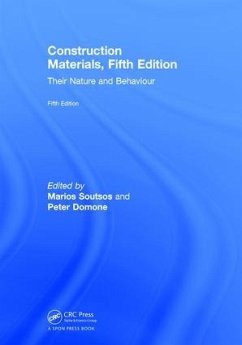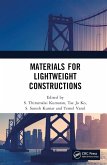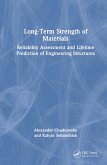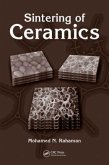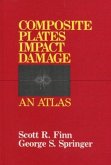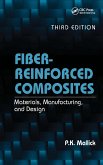Construction Materials
Their Nature and Behaviour, Fifth Edition
Herausgeber: Soutsos, Marios; Domone, Peter
Construction Materials
Their Nature and Behaviour, Fifth Edition
Herausgeber: Soutsos, Marios; Domone, Peter
- Gebundenes Buch
- Merkliste
- Auf die Merkliste
- Bewerten Bewerten
- Teilen
- Produkt teilen
- Produkterinnerung
- Produkterinnerung
This established textbook provides an understanding of materials' behaviour through knowledge of their chemical and physical structure. It offers clear and comprehensive analysis on the full range of materials used in construction, to form a must-have for civil engineering students and those on architecture, surveying and construction courses.
Andere Kunden interessierten sich auch für
![Materials for Lightweight Constructions Materials for Lightweight Constructions]() Materials for Lightweight Constructions153,99 €
Materials for Lightweight Constructions153,99 €![Design, Fabrication, Properties and Applications of Smart and Advanced Materials Design, Fabrication, Properties and Applications of Smart and Advanced Materials]() Design, Fabrication, Properties and Applications of Smart and Advanced Materials276,99 €
Design, Fabrication, Properties and Applications of Smart and Advanced Materials276,99 €![Long-Term Strength of Materials Long-Term Strength of Materials]() Alexander ChudnovskyLong-Term Strength of Materials175,99 €
Alexander ChudnovskyLong-Term Strength of Materials175,99 €![Sintering of Ceramics Sintering of Ceramics]() Mohamed N RahamanSintering of Ceramics155,99 €
Mohamed N RahamanSintering of Ceramics155,99 €![Composite Plates Impact Damage Composite Plates Impact Damage]() Scottr FinnComposite Plates Impact Damage154,99 €
Scottr FinnComposite Plates Impact Damage154,99 €![Mechanics of Materials Mechanics of Materials]() Clarence W de SilvaMechanics of Materials183,99 €
Clarence W de SilvaMechanics of Materials183,99 €![Fiber-Reinforced Composites Fiber-Reinforced Composites]() P K MallickFiber-Reinforced Composites197,99 €
P K MallickFiber-Reinforced Composites197,99 €-
-
-
This established textbook provides an understanding of materials' behaviour through knowledge of their chemical and physical structure. It offers clear and comprehensive analysis on the full range of materials used in construction, to form a must-have for civil engineering students and those on architecture, surveying and construction courses.
Hinweis: Dieser Artikel kann nur an eine deutsche Lieferadresse ausgeliefert werden.
Hinweis: Dieser Artikel kann nur an eine deutsche Lieferadresse ausgeliefert werden.
Produktdetails
- Produktdetails
- Verlag: CRC Press
- 5th edition
- Seitenzahl: 864
- Erscheinungstermin: 12. Oktober 2017
- Englisch
- Abmessung: 257mm x 183mm x 51mm
- Gewicht: 1724g
- ISBN-13: 9781138500563
- ISBN-10: 1138500569
- Artikelnr.: 57054812
- Herstellerkennzeichnung
- Libri GmbH
- Europaallee 1
- 36244 Bad Hersfeld
- gpsr@libri.de
- Verlag: CRC Press
- 5th edition
- Seitenzahl: 864
- Erscheinungstermin: 12. Oktober 2017
- Englisch
- Abmessung: 257mm x 183mm x 51mm
- Gewicht: 1724g
- ISBN-13: 9781138500563
- ISBN-10: 1138500569
- Artikelnr.: 57054812
- Herstellerkennzeichnung
- Libri GmbH
- Europaallee 1
- 36244 Bad Hersfeld
- gpsr@libri.de
Marios Soutsos is a professor of Structures/Materials at Queen's University Belfast. Peter Domone is an honorary senior lecturer at University College London.
Part I: Fundamentals
Revised and updated by Peter Domone and Marios Soutsos, with acknowledgment
to the previous authors Bill Biggs, Ian McColl and Bob Moon
Chapter 1: Atoms, Bonding, Energy and Equilibrium
Chapter 2: Mechanical Properties of Solids
Chapter 3: Structure of Solids
Chapter 4: Fracture and Toughness
Chapter 5: Liquids, Viscoelasticity and Gels
Chapter 7: Electrical and Thermal Properties
Example Questions
Further Reading
Part II: Metals and Alloys
Revised and updated Marios Soutsos and Peter Domone, with acknowledgment to
the previous authors Bill Biggs, Ian McColl and Bob Moon
Chapter 8: Deformation and Strengthening of Metals
Chapter 9: Forming of Metals
Chapter 10: Oxidation and Corrosion
Chapter 11: Iron and Steel
Chapter 12: Aluminium
Example Questions
Further Reading
Part III: Concrete
Marios Soutsos and Peter Domone
Chapter 13: Portland Cements
Chapter 14: Admixtures
Chapter 15: Additions
Chapter 16: Other Types of Cement
Chapter 17: Aggregates for Concrete
Chapter 18: Properties of Fresh Concrete
Chapter 19: Early Age Properties of Concrete
Chapter 20: Deformation of Concrete
Chapter 21: Strength and Failure of Concrete
Chapter 22: Concrete Mix Design
Chapter 23: Non-Destructive Testing of Hardened Concrete
Chapter 24: Durability of Concrete
Chapter 25: Special Concretes
Chapter 26: Recycling of Concrete
Example Questions
Further Reading
Part IV: Polymers
Revised and updated by Vasileios Koutsos with acknowledgement to the
previous author Len Holloway
Chapter 27: Polymer Types, Properties and Applications
Further Reading
Part V: Fibre Composites FRP and FRC
Philip Purnell
Chapter 28: Reinforcing Fibre Materials
Chapter 29: Reinforcing Fibre Architecture
Chapter 30: Matrices
Chapter 31: Interfaces and Bonding
Chapter 32: Mechanical Behaviour and Properties of Composites
Chapter 33: Manufacture of Fibre Composites
Chapter 34: Applications of Fibre Composites in Construction.
Chapter 35: Durability
Chapter 36: Recycling
Further Reading
Part VI: Glass
Graham Dodd
Chapter 37: Manufacture and Processing
Chapter 38: Properties and Performance
Chapter 39: Design and Applications
Chapter 40: Service and End of Life
Further Reading
Part VII: Timber
John Dinwoodie
Chapter 41: Structure of Timber and the Presence of Moisture
Chapter 42: Deformation in Timber
Chapter 43: Strength and Failure in Timber
Chapter 44: Durability of Timber
Chapter 45: Processing and Recycling of Timber
Example Questions
Acknowledgment, Further Reading and Sources of Information
Part VIII: Masonry
Revised and updated by Paulo B. Lourenço with acknowledgment to the
previous author Bob de Vekey
Chapter 46: Materials and Components for Masonry
Chapter 47: Masonry Construction and Forms
Chapter 48: Structural Behaviour and Movement of Masonry
Chapter 49: Non-Structural Physical Properties of Masonry
Chapter 50: Deterioration, Conservation and Strengthening of Masonry
Example Questions
Further Reading and Sources of Information
Part IX: Bituminous Materials
Gordon D. Airey
Chapter 51: Components of Bituminous Materials
Chapter 52: Viscosity, Stiffness and Deformation of Bituminous Materials
Chapter 53: Strength and Failure of Bituminous Materials
Chapter 54: Durability of Bituminous Mixtures
Chapter 55: Design and Production of Bituminous Materials
Chapter 56: Recycling of Bituminous Materials
Example Questions
Further Reading
Part X: Selection and Sustainable Use of Materials
Marios Soutsos and Peter Domone
Chapter 57: Mechanical Properties of Materials
Chapter 58: Sustainability and Construction Materials
Revised and updated by Peter Domone and Marios Soutsos, with acknowledgment
to the previous authors Bill Biggs, Ian McColl and Bob Moon
Chapter 1: Atoms, Bonding, Energy and Equilibrium
Chapter 2: Mechanical Properties of Solids
Chapter 3: Structure of Solids
Chapter 4: Fracture and Toughness
Chapter 5: Liquids, Viscoelasticity and Gels
Chapter 7: Electrical and Thermal Properties
Example Questions
Further Reading
Part II: Metals and Alloys
Revised and updated Marios Soutsos and Peter Domone, with acknowledgment to
the previous authors Bill Biggs, Ian McColl and Bob Moon
Chapter 8: Deformation and Strengthening of Metals
Chapter 9: Forming of Metals
Chapter 10: Oxidation and Corrosion
Chapter 11: Iron and Steel
Chapter 12: Aluminium
Example Questions
Further Reading
Part III: Concrete
Marios Soutsos and Peter Domone
Chapter 13: Portland Cements
Chapter 14: Admixtures
Chapter 15: Additions
Chapter 16: Other Types of Cement
Chapter 17: Aggregates for Concrete
Chapter 18: Properties of Fresh Concrete
Chapter 19: Early Age Properties of Concrete
Chapter 20: Deformation of Concrete
Chapter 21: Strength and Failure of Concrete
Chapter 22: Concrete Mix Design
Chapter 23: Non-Destructive Testing of Hardened Concrete
Chapter 24: Durability of Concrete
Chapter 25: Special Concretes
Chapter 26: Recycling of Concrete
Example Questions
Further Reading
Part IV: Polymers
Revised and updated by Vasileios Koutsos with acknowledgement to the
previous author Len Holloway
Chapter 27: Polymer Types, Properties and Applications
Further Reading
Part V: Fibre Composites FRP and FRC
Philip Purnell
Chapter 28: Reinforcing Fibre Materials
Chapter 29: Reinforcing Fibre Architecture
Chapter 30: Matrices
Chapter 31: Interfaces and Bonding
Chapter 32: Mechanical Behaviour and Properties of Composites
Chapter 33: Manufacture of Fibre Composites
Chapter 34: Applications of Fibre Composites in Construction.
Chapter 35: Durability
Chapter 36: Recycling
Further Reading
Part VI: Glass
Graham Dodd
Chapter 37: Manufacture and Processing
Chapter 38: Properties and Performance
Chapter 39: Design and Applications
Chapter 40: Service and End of Life
Further Reading
Part VII: Timber
John Dinwoodie
Chapter 41: Structure of Timber and the Presence of Moisture
Chapter 42: Deformation in Timber
Chapter 43: Strength and Failure in Timber
Chapter 44: Durability of Timber
Chapter 45: Processing and Recycling of Timber
Example Questions
Acknowledgment, Further Reading and Sources of Information
Part VIII: Masonry
Revised and updated by Paulo B. Lourenço with acknowledgment to the
previous author Bob de Vekey
Chapter 46: Materials and Components for Masonry
Chapter 47: Masonry Construction and Forms
Chapter 48: Structural Behaviour and Movement of Masonry
Chapter 49: Non-Structural Physical Properties of Masonry
Chapter 50: Deterioration, Conservation and Strengthening of Masonry
Example Questions
Further Reading and Sources of Information
Part IX: Bituminous Materials
Gordon D. Airey
Chapter 51: Components of Bituminous Materials
Chapter 52: Viscosity, Stiffness and Deformation of Bituminous Materials
Chapter 53: Strength and Failure of Bituminous Materials
Chapter 54: Durability of Bituminous Mixtures
Chapter 55: Design and Production of Bituminous Materials
Chapter 56: Recycling of Bituminous Materials
Example Questions
Further Reading
Part X: Selection and Sustainable Use of Materials
Marios Soutsos and Peter Domone
Chapter 57: Mechanical Properties of Materials
Chapter 58: Sustainability and Construction Materials
Part I: Fundamentals
Revised and updated by Peter Domone and Marios Soutsos, with acknowledgment
to the previous authors Bill Biggs, Ian McColl and Bob Moon
Chapter 1: Atoms, Bonding, Energy and Equilibrium
Chapter 2: Mechanical Properties of Solids
Chapter 3: Structure of Solids
Chapter 4: Fracture and Toughness
Chapter 5: Liquids, Viscoelasticity and Gels
Chapter 7: Electrical and Thermal Properties
Example Questions
Further Reading
Part II: Metals and Alloys
Revised and updated Marios Soutsos and Peter Domone, with acknowledgment to
the previous authors Bill Biggs, Ian McColl and Bob Moon
Chapter 8: Deformation and Strengthening of Metals
Chapter 9: Forming of Metals
Chapter 10: Oxidation and Corrosion
Chapter 11: Iron and Steel
Chapter 12: Aluminium
Example Questions
Further Reading
Part III: Concrete
Marios Soutsos and Peter Domone
Chapter 13: Portland Cements
Chapter 14: Admixtures
Chapter 15: Additions
Chapter 16: Other Types of Cement
Chapter 17: Aggregates for Concrete
Chapter 18: Properties of Fresh Concrete
Chapter 19: Early Age Properties of Concrete
Chapter 20: Deformation of Concrete
Chapter 21: Strength and Failure of Concrete
Chapter 22: Concrete Mix Design
Chapter 23: Non-Destructive Testing of Hardened Concrete
Chapter 24: Durability of Concrete
Chapter 25: Special Concretes
Chapter 26: Recycling of Concrete
Example Questions
Further Reading
Part IV: Polymers
Revised and updated by Vasileios Koutsos with acknowledgement to the
previous author Len Holloway
Chapter 27: Polymer Types, Properties and Applications
Further Reading
Part V: Fibre Composites FRP and FRC
Philip Purnell
Chapter 28: Reinforcing Fibre Materials
Chapter 29: Reinforcing Fibre Architecture
Chapter 30: Matrices
Chapter 31: Interfaces and Bonding
Chapter 32: Mechanical Behaviour and Properties of Composites
Chapter 33: Manufacture of Fibre Composites
Chapter 34: Applications of Fibre Composites in Construction.
Chapter 35: Durability
Chapter 36: Recycling
Further Reading
Part VI: Glass
Graham Dodd
Chapter 37: Manufacture and Processing
Chapter 38: Properties and Performance
Chapter 39: Design and Applications
Chapter 40: Service and End of Life
Further Reading
Part VII: Timber
John Dinwoodie
Chapter 41: Structure of Timber and the Presence of Moisture
Chapter 42: Deformation in Timber
Chapter 43: Strength and Failure in Timber
Chapter 44: Durability of Timber
Chapter 45: Processing and Recycling of Timber
Example Questions
Acknowledgment, Further Reading and Sources of Information
Part VIII: Masonry
Revised and updated by Paulo B. Lourenço with acknowledgment to the
previous author Bob de Vekey
Chapter 46: Materials and Components for Masonry
Chapter 47: Masonry Construction and Forms
Chapter 48: Structural Behaviour and Movement of Masonry
Chapter 49: Non-Structural Physical Properties of Masonry
Chapter 50: Deterioration, Conservation and Strengthening of Masonry
Example Questions
Further Reading and Sources of Information
Part IX: Bituminous Materials
Gordon D. Airey
Chapter 51: Components of Bituminous Materials
Chapter 52: Viscosity, Stiffness and Deformation of Bituminous Materials
Chapter 53: Strength and Failure of Bituminous Materials
Chapter 54: Durability of Bituminous Mixtures
Chapter 55: Design and Production of Bituminous Materials
Chapter 56: Recycling of Bituminous Materials
Example Questions
Further Reading
Part X: Selection and Sustainable Use of Materials
Marios Soutsos and Peter Domone
Chapter 57: Mechanical Properties of Materials
Chapter 58: Sustainability and Construction Materials
Revised and updated by Peter Domone and Marios Soutsos, with acknowledgment
to the previous authors Bill Biggs, Ian McColl and Bob Moon
Chapter 1: Atoms, Bonding, Energy and Equilibrium
Chapter 2: Mechanical Properties of Solids
Chapter 3: Structure of Solids
Chapter 4: Fracture and Toughness
Chapter 5: Liquids, Viscoelasticity and Gels
Chapter 7: Electrical and Thermal Properties
Example Questions
Further Reading
Part II: Metals and Alloys
Revised and updated Marios Soutsos and Peter Domone, with acknowledgment to
the previous authors Bill Biggs, Ian McColl and Bob Moon
Chapter 8: Deformation and Strengthening of Metals
Chapter 9: Forming of Metals
Chapter 10: Oxidation and Corrosion
Chapter 11: Iron and Steel
Chapter 12: Aluminium
Example Questions
Further Reading
Part III: Concrete
Marios Soutsos and Peter Domone
Chapter 13: Portland Cements
Chapter 14: Admixtures
Chapter 15: Additions
Chapter 16: Other Types of Cement
Chapter 17: Aggregates for Concrete
Chapter 18: Properties of Fresh Concrete
Chapter 19: Early Age Properties of Concrete
Chapter 20: Deformation of Concrete
Chapter 21: Strength and Failure of Concrete
Chapter 22: Concrete Mix Design
Chapter 23: Non-Destructive Testing of Hardened Concrete
Chapter 24: Durability of Concrete
Chapter 25: Special Concretes
Chapter 26: Recycling of Concrete
Example Questions
Further Reading
Part IV: Polymers
Revised and updated by Vasileios Koutsos with acknowledgement to the
previous author Len Holloway
Chapter 27: Polymer Types, Properties and Applications
Further Reading
Part V: Fibre Composites FRP and FRC
Philip Purnell
Chapter 28: Reinforcing Fibre Materials
Chapter 29: Reinforcing Fibre Architecture
Chapter 30: Matrices
Chapter 31: Interfaces and Bonding
Chapter 32: Mechanical Behaviour and Properties of Composites
Chapter 33: Manufacture of Fibre Composites
Chapter 34: Applications of Fibre Composites in Construction.
Chapter 35: Durability
Chapter 36: Recycling
Further Reading
Part VI: Glass
Graham Dodd
Chapter 37: Manufacture and Processing
Chapter 38: Properties and Performance
Chapter 39: Design and Applications
Chapter 40: Service and End of Life
Further Reading
Part VII: Timber
John Dinwoodie
Chapter 41: Structure of Timber and the Presence of Moisture
Chapter 42: Deformation in Timber
Chapter 43: Strength and Failure in Timber
Chapter 44: Durability of Timber
Chapter 45: Processing and Recycling of Timber
Example Questions
Acknowledgment, Further Reading and Sources of Information
Part VIII: Masonry
Revised and updated by Paulo B. Lourenço with acknowledgment to the
previous author Bob de Vekey
Chapter 46: Materials and Components for Masonry
Chapter 47: Masonry Construction and Forms
Chapter 48: Structural Behaviour and Movement of Masonry
Chapter 49: Non-Structural Physical Properties of Masonry
Chapter 50: Deterioration, Conservation and Strengthening of Masonry
Example Questions
Further Reading and Sources of Information
Part IX: Bituminous Materials
Gordon D. Airey
Chapter 51: Components of Bituminous Materials
Chapter 52: Viscosity, Stiffness and Deformation of Bituminous Materials
Chapter 53: Strength and Failure of Bituminous Materials
Chapter 54: Durability of Bituminous Mixtures
Chapter 55: Design and Production of Bituminous Materials
Chapter 56: Recycling of Bituminous Materials
Example Questions
Further Reading
Part X: Selection and Sustainable Use of Materials
Marios Soutsos and Peter Domone
Chapter 57: Mechanical Properties of Materials
Chapter 58: Sustainability and Construction Materials

